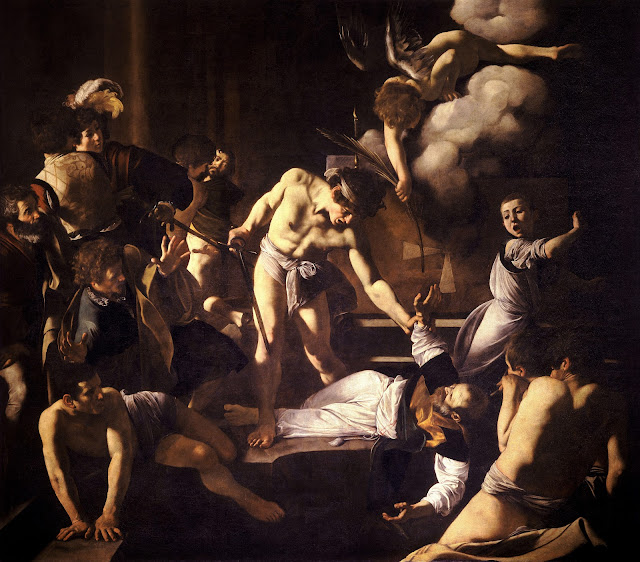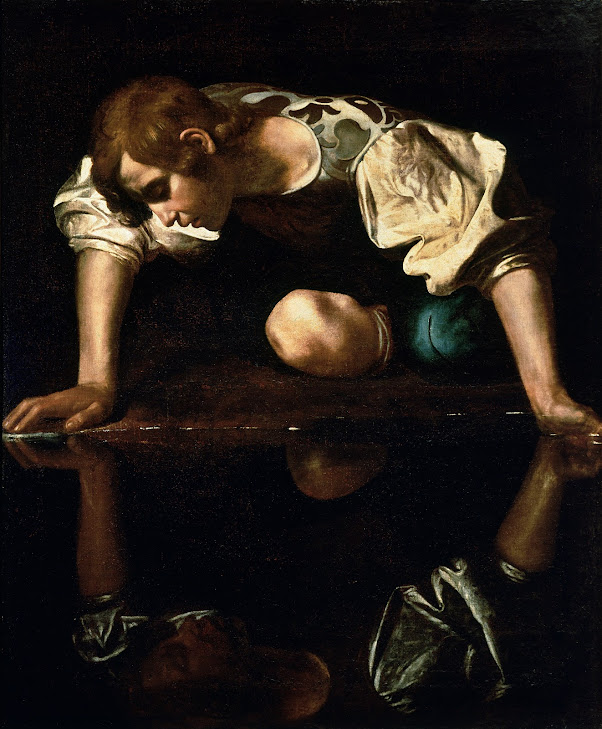Michelangelo Merisi (Michele Angelo Merigi or Amerighi) da Caravaggio, born the son of Fermo Merisi of Caravaggio in Milan, he trained there from 1584 onwards as an apprentice to Simone Peterzano. The date of his arrival in Rome is not documented. In the mid-1590s, he was taken into the household of his patron, Cardinal Francesco Maria del Monte, in the Palazzo Madama. Through Del Monte, he met Vincenzo Giustiniani, another important patron. In 1599, Caravaggio received his first public commission, the painting of the altarpieces of the Contarelli Chapel; this was followed by the side paintings in the Cerasi Chapel. From 1602/03 on, he was commissioned to paint works for the most important Roman families, including the Matteis, the Barberinis and the Borgheses. In May 1606, Caravaggio killed Ranuccio Tomassoni in a dispute, whereupon he fled to Naples. From 1607 on, he stayed in Malta, but was forced to flee from the island the following year due to a conflict and, after a one-year sojourn in Sicily, returned to Naples. On his journey back to Rome, Caravaggio died in Porto Ercole on 18 July 1610.
For more biographical notes, and for earlier works, see part 1 also.
This is part 2 of a 3-part series on the works of Caravaggio:
 |
| 1600 The Conversion on the way to Damascus oil on canvas 230 x 175 cm Basilica of Santa Maria del Popolo, Rome |
The painting depicts this moment recounted in the Acts of the Apostles, except Caravaggio has Saul falling off a horse (which is not mentioned in the story) on the road to Damascus, seeing a blinding light and hearing the voice of Jesus. For Saul this is a moment of intense religious ecstasy: he is lying on the ground, supine, eyes shut, with his legs spread and his arms raised upward as if embracing his vision. The saint is a muscular young man, and his garment looks like a Renaissance version of a Roman soldier's attire: orange and green muscle cuirass, pteruges (strip-like defences for the upper parts of limbs attached to armour in the Greco-Roman world), tunic and boots. His plumed helmet fell off his head and his sword is lying by his side. The red cape almost looks like a blanket under his body. The horse is passing over him led by an old groom, who points his finger at the ground. He had calmed down the animal, and now prevents it treading upon Saul. The huge steed has a mottled brown and cream coat; it is still foaming at the mouth, and its hoof is hanging in the air.
 |
| 1600 The Crucifixion of Saint Peter oil on canvas 230 x 175 cm Santa Maria del Popolo, Rome |
The painting depicts the martyrdom of St. Peter. According to ancient and well-known tradition, Peter, when he was condemned to death in Rome, requested to be crucified upside-down because he did not believe that a man is worthy to be killed in the same manner as Jesus Christ.
The large canvas shows the three executioners fighting to straighten the cross. Peter is already nailed to the rafters, his hands and feet are bleeding. The apostle is practically naked, which emphasises his vulnerability. He is an old man, with a grey beard and a bald head, but his ageing body is still muscular, suggesting considerable strength. He rises from the cross with great effort, turning his whole body, as if he wants to look towards something that is out of the picture (God).
 |
| 1600-01 David with the Head of Goliath oil on poplar wood panel 91.2 x 116.2 cm Kunsthistorisches Museum, Vienna |
In May 1606 Caravaggio was accused of murder and fled from Rome to distant lands (Naples, Sicily, Malta) to escape the price that had been placed on his head. His self-portrait as Goliath's severed head, held by David his executioner, was sent to the papal court in 1610 as a kind of painted petition for pardon. In fact pardon was granted, but did not reach Caravaggio before he died in Porto Ercole.
David assumes the pose for all allegories of Justice, with a sword in the right hand (but with scales instead of the head in the left).
The relation to Christ, who is the ultimate judge as well as saviour, is evident. David may sorrow, but even in his compassion he bears the burden of the dispensation of justice firmly. Caravaggio’s sardonic representation of himself as Goliath is despairing.
 |
| c1600 The Conversion of Saint Paul oil on cypress wood panel 189 x 237 cm Odescalchi Balbi Collection, Rome |
The painting, together with a Crucifixion of Saint Peter, was commissioned by Monsignor (later Cardinal) Tiberio Cesari, Treasurer-General to Pope Clement VIII, in September 1600. According to Caravaggio's early biographer Giovanni Baglione, both paintings were rejected by Cerasi, and replaced by the second versions which hang in the chapel today. The dates of completion and rejection are determined from the death of Cerasi in May 1601. Baglione states that the first versions of both paintings were taken by Cardinal Giacomo Sannessio, but another early writer, Giulio Mancini, says that Sannessio's paintings were copies. Nevertheless, most scholars are satisfied that this is the first version of the Conversion of Paul.
The painting records the moment when Saul of Tarsus, on his way to Damascus to annihilate the Christian community there, is struck blind by a brilliant light and hears the voice of Christ saying, "Saul, Saul, why persecutest thou me?...And they that were with me saw indeed the light, and were afraid, but they heard not the voice...". Elsewhere Paul claims to have seen Christ during a vision, and it is on this basis that he grounds his claim be recognised as an Apostle: "Have I not seen Jesus Christ our Lord?”
 |
| 1601 Cupid as Victor oil on canvas 156.5 x 113.3cm Gemäldegalerie, Berlin |
The young Cupid, following Virgil's saying "Amor vincit omnia" (Love conquers all), triumphs over science, art, fame and power, whose symbols are strewn at his feet: musical instruments, straight-edge, laurel wreath, and pieces of armour. The boy's ambiguous mocking smile and the provocatively importunate pose suggest that earthly love is mocking the highest moral and intellectual values of human ambition. The boy's precarious position, with his left leg an the edge of a draped bed, so that his genitals thrust almost into the centre of the picture, strikes a homoerotic note. The chiaroscuro and the incredibly natural quality of the figures are typical of Caravaggio.
 |
| 1601 Supper at Emmaus oil on canvas 141 x 196 cm The National Gallery, London |
On the third day after the Crucifixion two of Jesus’s disciples were walking to Emmaus when they met the resurrected Christ. They failed to recognise him, but that evening at supper he ‘... took bread, and blessed it, and brake and gave to them. And their eyes were opened, and they knew him; and he vanished out of their sight’ (Luke 24: 30–31).
Painted at the height of Caravaggio’s fame, this is among his most impressive domestic religious pictures. He captures the dramatic climax of the story, the moment when the disciples suddenly see what has been in front of them all along. Their actions convey their astonishment: one is about to leap out of his chair while the other throws out his arms in a gesture of disbelief. Typically for Caravaggio, he has shown the disciples as ordinary working men, with bearded, lined faces and ragged clothes, in contrast to the youthful beardless Christ, who seems to have come from a different world.
 |
| 1606 Supper at Emmaus oil on canvas 141 x 175 cm Pinacoteca di Brera, Italy |
%20oil%20on%20canvas%20106.9%20x%20146%20cm%20Sanssouci%20Picture%20Gallery,%20Potsdam,%20Germany.jpg) |
| 1601-02 The Incredulity of Saint Thomas (Doubting Thomas) oil on canvas 106.9 x 146 cm Sanssouci Picture Gallery, Potsdam, Germany |
“Unless I see the nail marks in his hands and put my finger where the nails were, and put my hand into his side, I will not believe it.” said St Thomas when first told of Jesus’ return beyond the grave. Yet in a week’s time Jesus appeared in front of him and said “Put your finger here; see my hands. Reach out your hand and put it into my side. Stop doubting and believe.” Prompting one of the more famous pokes in art history.
Giulio Mancini thought Caravaggio modelled a prostitute, possibly his mistress, as the Virgin. Giovanni Baglione and Gian Pietro Bellori attributed the rejection to the appearance of the Virgin.
The breach of decorum led to a rejection of the painting by the fathers of Santa Maria della Scala and its replacement by a picture by Carlo Daraceni, a close follower of Caravaggio.
On a recommendation by Peter Paul Rubens, who praised it as one of Caravaggio's best works, the painting was bought b Vicenzo Gonzaga, Duke of Mantua. Giovanni Magni, the duke's ambassador, briefly exhibited the painting in his house on the Via del Corso, between 1 and 7 April 1607.Copying was absolutely forbidden.
The Duke's collection was sold to Charles I of England in 1627. After his execution the English Commonwealth put his collection up for sale in 1649, and the painting was bought by Everhard Jabach, who in 1671 sold it to Louis XIV for the French Royal Collection, which after the French Revolution became the property of the state.
%20oil%20on%20canvas%20129%20x%2095%20cm%20Capitoline%20Museums,%20Rome.jpg) |
| 1602 Saint John the Baptist (Youth with a Ram) oil on canvas 129 x 95 cm Capitoline Museums, Rome |
There has been much debate on the subject of this painting. It could be Isaac, petting the ram that is to be slaughtered by Abraham. However, from the administration of Ciriaco Mattei, who had commissioned the work, it appears that he paid for St. John the Baptist. Ciriaco was the brother of Cardinal Mattei, in whose Roman palazzo Caravaggio lived between 1601 and 1603.
The most likely provenance for this iconographically unusual painting was first constructed by Denis Mahon in 1955, who argues that it was commissioned by Ciriaco Mattei, was given by him to his son, Giovanni Battista, who bore the same name as the Saint, and was the bequeathed by the son in wills of January 1623 and June 1624 to Cardinal del Monte. The painting was listed in the del Monte inventory of 1627 and sold at the del Monte sale of 1628 to Cardina Pio. It was sold by the Pio family to Pope Benedict XIV in 1749-50 to be lodged in the newly founded Capitoline museum.
 |
| 1602 The Inspiration of Saint Matthew oil on canvas 292 x 186 cm San Luigi dei Francesi, Rome |
Commissioned by the French Cardinal Matteo Contarelli, the canvas hangs in Contarelli chapel altar in the church of the French congregation San Luigi dei Francesi in Rome. It is one of three Caravaggio canvases in the chapel: hanging between the larger earlier canvases of The Martyrdom of Saint Matthew, and The Calling odf Saint Matthew. This was not an easy commission for Caravaggio, and at least two of the three paintings had to be either replaced or repainted to satisfy his patron, the Cardinal Del Monte.
.jpg) |
| 1602 The Taking of Christ oil on canvas 133.5 x 169.5 cm National Gallery of Ireland, Dublin |
Caravaggio painted this for the Roman Marquis Ciriaco Mattei in 1602. Offering a new visual approach to the biblical story, Caravaggio placed the figures close to the picture plane and used a strong light-and-dark contrast, giving the scene an extraordinary sense of drama.
Judas has identified Christ with a kiss, as the temple guards move in to seize Him. The fleeing disciple in disarray on the left is St John the Evangelist. Only the moon lights the scene. Although the man at the far right is holding a lantern, it is, in reality, an ineffective source of illumination. In that man’s features Caravaggio portrayed himself, aged 31, as an observer of events, a device he frequently used in his paintings.
The painting was a well-documented commission, and was frequently copied by contemporary artists. By the twentieth century, however, the painting had disappeared, having been sold by the family in 1802, and misattributed to Gerrit van Honthorst, a Dutch follower of Caravaggio. Scholars resumed searching for the original in the 1940s, as many of them no longer accepted the authenticity of a painting in the Odessa Art Museum, now known to be a copy made for another member of the Mattei family in 1626. The painting has now regained its status as a key work by Caravaggio, completed during the artist’s short, but highly productive, period in Rome.
.jpg) |
| 1602-03 The Crowning with Thorns oil on canvas 178 x 125 cm Palazzo degli Alberti, Prato, Italy |
The artist uses light and shadow to draw attention to the central figure of Christ and in particular, to his bare right shoulder and arm and his upturned face. Nothing is known about the commission. The painting only came to light after 1916 and then was thought to be a copy of a lost original. But this opinion changed when it was cleaned in and restored in 1974/75. The restoration showed that it had been extensively repainted. Perhaps this was because it was just too realistic. This is not your average devotional image. There is a realism about it which is quite shocking even today.
 |
| c1602-03 The Entombment of Christ oil on canvas 300 x 203 cm Pinacoteca Vaticana, Rome |
Created for the second chapel on the right in Santa Maris Vallicella (the Chiesa Nuova), a church built for the Oratory of Saint Philip Neri. The painting consists of a tightly compact figurative group consisting of six people, including the dead Christ. The upper half of Christ's body (that of a muscular labourer) is being supported by John the Evangelist (in the red cloak) (or possibly Joseph of Arimathea), his right hand inadvertently fingering Christ's stab wound; the lower half is carried supported by Saint Nicodemus, who traditionally removed the nails from Christ's feet on the cross. Nicodemus is the dominant character in the picture and his body is its compositional and spiritual anchor. Historically a man of wealth, he is portrayed here as a working man, whose deliberately designed troll-like form suggests devoted service to his deceased Lord. He stares unflinchingly at us out of the picture-plane, almost challenging us to interfere with the ritual, and in the process drawing us into the picture.
 |
| 1602-04 Christ Crowned with Thorns oil on canvas 127 x 165.5 cm Kunsthistorisches Museum, Vienna |
According to Caravaggio's biographer Giovanni Bellori, a Crowning with Thorns was made for Caravaggio's patron Vincenzo Giustiniani, and can be traced convincingly to the Giustiniani collection. An attribution to Giustiniani would place it in the period before 1606, when Caravaggio fled Rome, but Peter Robb dates it to 1607, when the artist was in Naples.
It depicts a crown of thorns being forced onto the head of Jesus before his crucifixion, to mock his claim to authority. The twisted body of Christ was influenced by the Belvedere Torso (see below). The painting was designed as a supraporte, to be hung over a doorway.
 |
The Belvedere Torso is a 1.59 m (5.2 ft) tall fragmentary marble statue of a male nude, known to be in Rome from the 1430s, and signed prominently on the front of the base by "Apollonios, son of Nestor, Athenian", who is unmentioned in ancient literature. It is now in the Museo Pio-Clementino in the Vatican Museums. Once believed to be a 1st-century BC original, the statue is now thought to be a copy from the 1st century BC or AD of an older statue, probably to be dated to the early 2nd century BC.
 |
| 1603-04 Saint John the Baptist oil on canvas 94 x 131 cm Galleria Nazionale d'Arte Antica, Rome |
 |
| 1603-04 St Francis in Prayer oil on canvas 130 x 98 cm Galleria Nazionale d'Arte Antica, Rome |
St. Francis's life of poverty and humility was a popular subject in Caravaggio's age. Peter Robb makes the point that St. Francis of Assisi, together with John the Baptist and St. Jerome, "...make up the trio of alienated males, young, mature and old, brooding and remote from human society, that M (i.e. Caravaggio) painted again and again", becoming, in effect, private icons for Caravaggio's own troubled life.
In the course of a libel trial in 1603 Caravaggio's friend Orazio Gentileschi stated that he had lent the artist a monk's robe several months before, and this painting could be connected. Gentileschi's evidence seems to be the main argument behind a 1602/1604 date; but Robb, on the grounds of the austere approach and less painterly technique of the work, believes that it may date from 1606, when Caravaggio had fled Rome as an outlaw following a death in a street brawl.
 |
| 1603-06 The Calling of Saints Peter and Andrew oil on canvas 140.1 x 176 cm The Royal Collection, UK |
A beardless Jesus gestures Peter (who was still called Simon at the time) and his brother Andrew to follow him: “Come ye after me, and I will make you to become fishers of men.”
According to the gospel Peter and Andrew were out fishing on a lake when they were called, Caravaggio gives his own interpretation. Because of his prominence, the man on the left is thought to be Peter.
It is only since 2006 that it has been attributed to Caravaggio. It was thought to be a copy of the lost original. A thorough cleaning operation revealed new details that pointed to the Italian master. The work was acquired by the English king Charles I in 1637; it was the discovery of the bill of sale that led historians to this painting in the Royal Collection.
 |
| c1603 Sacrifice of Isaac oil on canvas 104 x 135 cm Uffizi Gallery, Florence |
The painting depicts the sacrifice of Isaac by Abraham as written in Genesis 22, with some artistic variations. In Caravaggio's version, Abraham prepares to kill his son under God's guidance by knife—rather than fire—but is rescued just in time by an angel on the left. The use of light and shadow draws attention to Abraham's right hand and his pointed blade, with the three subjects surrounding in a well orchestrated radial position.
Posthumous identification has found that Abraham was modelled by Cecco Boneri—frequently depicted by Caravaggio—and Isaac is modelled by the same child as in his famed painting The Amor (1602). This reliance on models gives the painting an aura of authenticity, particularly regarding the angel whose wings are the only indication of a spiritual nature
%20oil%20on%20canvas%20105%20x%2084%20cm%20Denver%20Art%20Museum,%20Colorado.jpg) |
| c1603 Still Life with Fruit (on a stone ledge) oil on canvas 105 x 84 cm Denver Art Museum, Colorado |
This painting is one of just a few still life artworks produced by Caravaggio. It has been variously dated between 1601 and 1610 (Caravaggio scholar John T. Spike lists the date as circa 1603 in the second revised edition[1] of his study of the artist). It depicts a wicker basket heaped with various fruit and vegetables sitting on a stone table, caught in Caravaggio's usual strong yet mellow shaft of light falling from top left, "as if through a hole in the ceiling." (Caravaggio at around this time was sued by a landlady for having cut a hole in the ceiling of the rooms he rented, presumably to create his characteristic lighting). The bulk of the space is taken up by the large melons, marrows and pumpkins, the watermelon and pumpkin cut open to display the interior, the marrows, long and twisting, seeming to wish to escape the two-dimensional space of the picture plane.
 |
| 1604 Saint John the Baptist in the Wilderness oil on canvas 172.7 x 132 cm Nelson-Atkins Museum of Art, Kansas City, Missouri |
In this Saint John the Baptist, Caravaggio has traded idealism for what oftentimes became in his own time a controversial realism. He has literally stripped the Baptist of nearly all traditional attributes (halo, lamb and banderole inscribed Ecce Agnus Dei or Behold the Lamb of God) leaving the brooding intensity of the saint's emotional state as the subject of the painting. Saint John's solemn pensiveness is reinforced by a Caravaggio trademark: the dramatic contrast of deep, opaque shadows, playing across his body and shrouding the sockets of his eyes, with a bright light that illuminates the Baptist from above and to his right. This stark contrast of light and darkness, the brilliant scarlet of the saint's cloak and Caravaggio's placement of him in the foreground, close to our own space, all contribute to the dramatic impact of the painting. Evidence of Caravaggio's working method, in which he incised lines into the gesso ground to guide his hand while painting, can be easily seen along the sitter's left leg in the right corner. Caravaggio most likely borrowed the Baptist's pose from one of Michaelangelo’s seated prophets and sibyls on the ceiling of the Sistine Chapel in the Vatican, Rome.
 |
| 1604-06 Madonna of Loreto oil on canvas 250 x 150 cm Basilica of St. Augustine in Campo Marzio, Rome |
The painting depicts the apparition of the barefoot Virgim and naked child to two peasants on a pilgri;mage or, as some say, it is the quickening of the iconic statue of the Virgin. In 1603 the heirs of marquis Ermete Cavalletti, who had died on 21 July 1602, commissioned for the decoration of a family chapel, a painting on the theme of the Madonna of Loreto. Putting into practice the marquis's will, the Cavaletti's on 4 September 1603 purchased a chapel in the church of Sant'Agostino in Rome.
The painter Giovanni Baglione, a competitor who had successfully ensured Caravaggio was jailed during a libel trial, said that the unveiling of this painting "caused the common people to make a great cackle (schiamazzo) over it". The uproar was not surprising. The Virgin Mary, like her admiring pilgrims, is barefoot. The doorway or niche is not an exalted cumulus or bevy of putti, but a partly decrepit wall of flaking brick is visible. Only the merest halo sanctifies her and the baby. While beautiful, the Virgin Mary could be any woman, emerging from the night shadows.
 |
| 1605 Ecce Homo oil on canvas 128 x 103 cm Palazzo Bianco, Genoa, Italyjpg |
Ecce Homo (c. 1605/6 or 1609 according to John Gash.) Contemporary accounts claim the piece was part of an unannounced competition between three artists, and that the Caravaggio version was eventually sent to Spain.
According to Giambatista Cardi, nephew of the Florentine artist Cigoli, Cardinal Massimo Massimi commissioned paintings on the theme of Ecce Homo from three artists, Cigoli, Caravaggio, and Domenico Passignano, without informing the artists of the multiple commissions. Cardi claimed the cardinal preferred Cigoli's version. The Passignano painting has never resurfaced.
The scene is taken from the Gospel of John - Pontius Pilate displays Christ to the crowd with the words, "Ecce homo!" ("Behold the man”). Caravaggio's version of the scene combined Pilate's display with the earlier moment of Christ, already crowned with thorns, mockingly robed like a king by his tormentors. Massimi already possessed a Crowning with Thorns by Caravaggio (thought to be the Crowning with Thorns in Prato) and Ecce Homo may have been intended as a companion piece. Stylistically, the painting displays characteristics of Caravaggio's mature Roman-period style. The forms are visible close-up and modelled by dramatic light, the absence of depth or background, and the psychological realism of, the torturer, who seems to mix sadism with pity. Pilate, in keeping with tradition, is shown as a rather neutral and perhaps almost sympathetic figure. He is also depicted wearing anachronistic clothing which was more contemporary to Caravaggio's time.
1607-08 St. John the Baptist at the Well
This painting does not fit into the artist’s series of other St. John the Baptist works.
Only a few experts accept it as a genuine Caravaggio. Its colours are muted. A banner with writing on it, which is wound around the unusually well-defined Jacob’s Staff on the ground, has an inscription which, although the artist twists it skilfully. Can easily be read as: Agnus Dei, the Lamb of God. The painting possibly represents a late phase in the artist’s creative works. Jesus replied “Because you have seen me, you have believed: blessed are those who have not seen and yet have believed.”
 |
| 1605 Madonna of the Rosary oil on canvas 364.4 x 249.5 cm Kunsthistorisches Museum, Vienna |
The painting depicts Madonna holding on to the child Jesus surrounded by viewers. St Peter the martyr can be seen acting as a mediator, the picture shows his wounded head.
He points towards the presence of a crowned Madonna with the child Jesus. Madonna, on the other hand, turns towards St Dominic who is looking up to the people to dispense the rosaries to the people closing up space towards him on their knees. The Painting shows Mary playing the role of a mediator as the Boy Jesus is the focus of attention from both composition and content.
This painting differs from convention; there are poor barefoot men with dirty feet, and hands raised up trying to reach up to a single rosary that St Dominic is holding. A red drape frames the painting as Madonna and the child Jesus looks down the poor but faithful crowd. A Bleeding St Peter depicts his death caused violently by an axe blow from to his head, while a hooded member of Dominican order stands next to him.
 |
| 1605-06 Saint Jerome in his Study oil on canvas 112 x 157 cm Galleria Borghese. Rome |
 |
| 1605-06 Death of the Virgin Mary oil on canvas 369 x 245 cm Louvre Museum, Paris |
When he painted the Death of the Virgin, Caravaggio had been working in Rome for fifteen years. The painting was commissioned by Laerzio Cherubini. a papal lawyer, for his chapel in the Carmelite church of Santa Maria della Scala in Trastevere, Rome; the painting could not have been finished before 1605–06. The depiction of the Death of the Virgin caused a contemporary stir, and was rejected as unfit by the parish.
Giulio Mancini thought Caravaggio modelled a prostitute, possibly his mistress, as the Virgin, Giovanni Baglione and Gian Pietro Bellori attributed the rejection to the appearance of the Virgin. The breach of decorum led to a rejection of the painting by the fathers of Santa Maria della Scala and its replacement by a picture by Carlo Saraceni, a close follower of Caravaggio.
 |
| c1612 The Dormition of the Virgin by Carlo Saraceni oil on canvas 305.1 x 231.1 cm Metropolitan Museum of Art, New York |




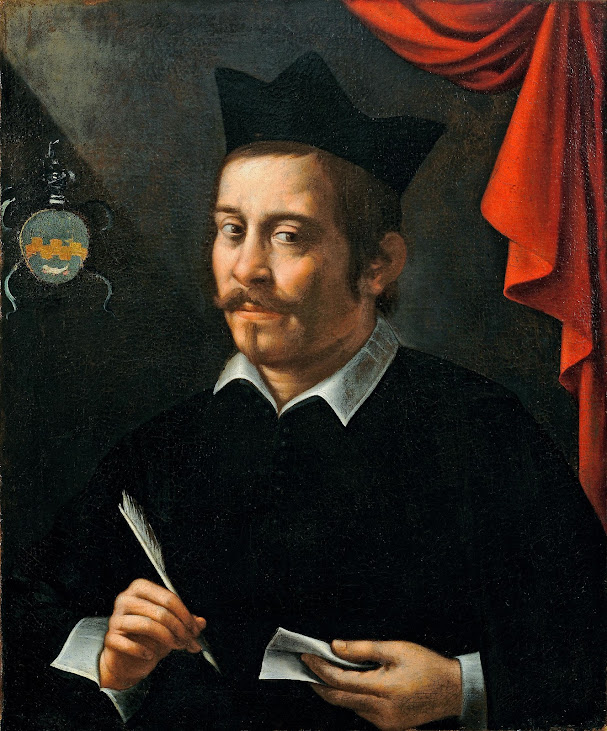






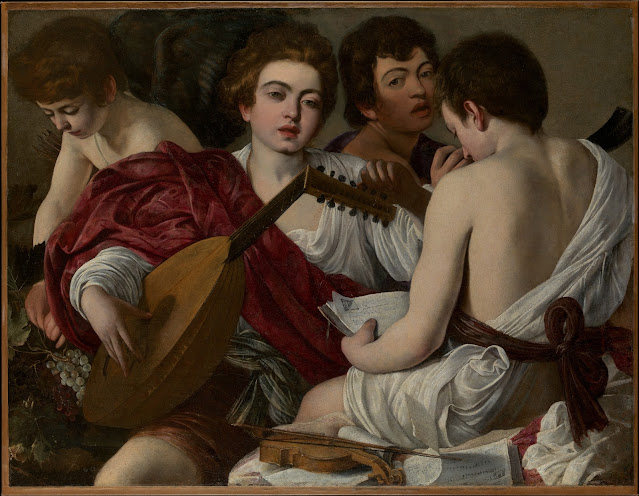


.jpg)


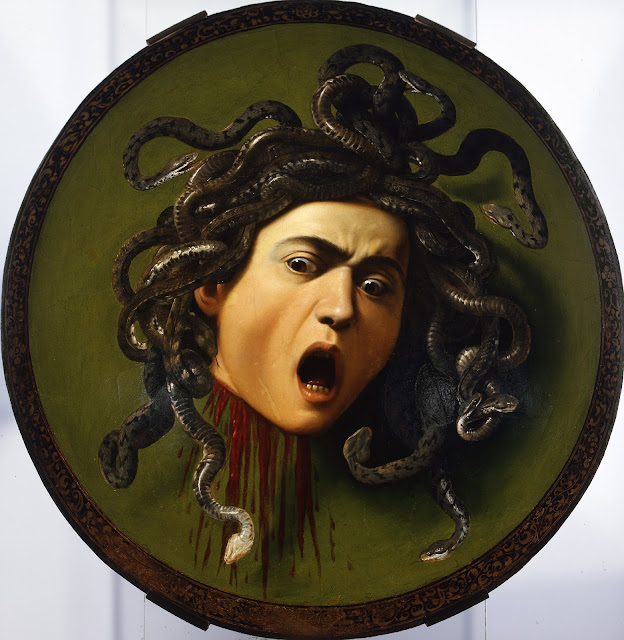
.jpg)
.jpg)





